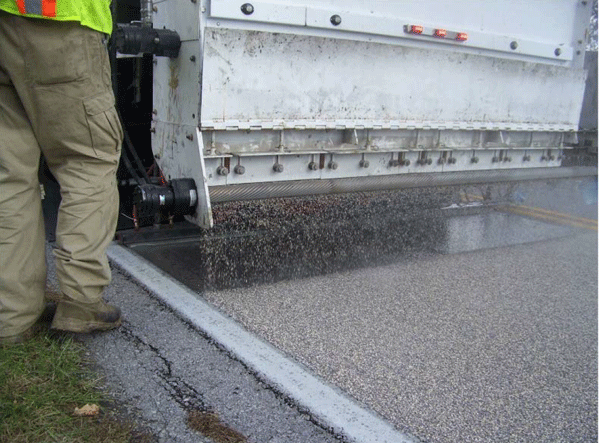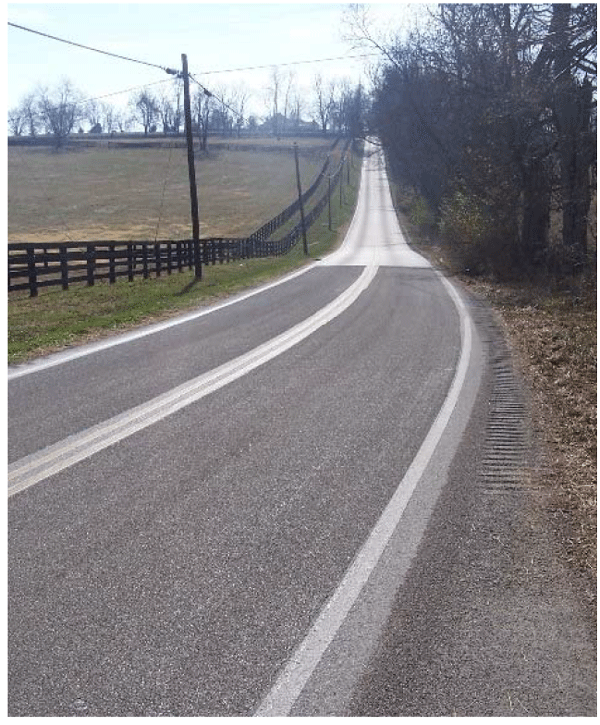U.S. Department of Transportation
Federal Highway Administration
1200 New Jersey Avenue, SE
Washington, DC 20590
202-366-4000
| < Previous | Table of Contents | Next > |
Between 2004 and 2008, more than 60 percent of all fatal crashes on Kentucky's roads were roadway departure crashes. In an effort to address this, the Kentucky Transportation Cabinet (KYTC), in conjunction with the Federal Highway Administration (FHWA), developed the 2009 Kentucky Roadway Departure Safety Implementation Plan, which established a strategic approach to reducing the number of roadway departure crashes on State roads. This statewide program is funded through the Highway Safety Improvement Program. As of summer 2014, KYTC has applied High Friction Surface Treatments (HFSTs) at more than 100 sites—many at locations that present multiple risk factors, such as multiple curves.
As part of the Roadway Departure Safety Implementation Plan, KYTC applied HFST to a number of state-maintained curves and ramps. HFSTs are a thin layer of specially engineered, durable, high friction aggregates placed as a topping on a polymer binder. These aggregate systems have long-lasting skid resistance and make the overlay more resistant to wear and polishing. Additional details are available at EDC 2012 Initiatives – High Friction Surface Treatment.
KYTC initially used a "black spot" approach to select treatment sites—selecting sites that had experienced the highest number of overall crashes. After this initial effort, KYTC continued to identify additional locations in need of improvement. KYTC regularly performs a screening prioritization, which scans the entire roadway network to identify wet-road crashes for additional candidates for HFST. After the site evaluation, pavement condition is examined for HFST application feasibility.

Figure F-1. Photo. A truck in the process of applying HFST to a curve.
In 2014, Kentucky updated the Roadway Departure Safety Implementation Plan and now uses a Highway Safety Manual (HSM) methodology to identify roadway segments and ramps as candidates for surface treatment. KYTC develops Safety Performance Functions and uses an empirical Bayes method to help identify curves/ramps that are candidates for surface treatment. More information is available at Introduction of Safety Performance Functions.
Almost immediate positive impacts were experienced at the 30 initial sites KYTC applied HFST. And multiple sources provided positive feedback on the program, including drivers, governing agencies, and policy makers. Data have shown a 70- to 75-percent reduction in crashes at the treated sites. Due to this success, several local agencies have expressed interest in implementing HFSTs.
One site in Fayette County–Exit 113 on Interstate 75–is illustrative of this success. In the 3 years prior to HFST treatment, the ramp had 28 roadway departure crashes (18 wet crashes and 10 dry crashes). In the two and half years since the HFST installation, crashes have nearly been eliminated and the ramp has been the scene of a single crash, which was a dry crash. Ramp signage was also updated at the same time as the HFST installation.
KYTC did not have outside guidance when it first began applying HFSTs due the relative newness of the treatment. Despite this, KYTC was able to apply numerous surface treatments in a short amount of time. KYTC staff suggests that other agencies should take the time to complete a thorough evaluation of each site when considering HFSTs. Also, agencies should implement a hierarchy of countermeasures, such as:
KYTC is pleased with the program and will continue to address the safety of curves and ramps with the HSM methodology. The application of HFST successfully decreased roadway departures and consequently, serious injuries and fatalities in Kentucky. With the help of Kentucky's leadership in the Roadway Departure Safety Plan, HFSTs are growing in popularity across the nation.

Figure F-2. Photo. A horizontal curve with HFST.
Tracy Lovell from the KYTC provided the information for this case study. Visit http://transportation.ky.gov/ for more information. All images are courtesy of the KYTC.
| < Previous | Table of Contents | Next > |
